| |
|
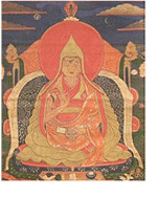
Buddhist Codes
Continue to Astonish
Over the last two years, we have published seven articles on Buddhist codes. In our continuing efforts to research this topic, we have a diverse collection of Dalai Lama, Siddhartha, and The Buddha codes to present. Some have been found doing a search of the entire Tanakh (Old Testament) for a word or phrase and then examining the shortest skips for extensions, and in others we were looking at a particular passage of Scripture because either another code passed through there, or because of the content of the surface text.
Nathan Jacobi, Ph.D., parsed and translated the codes.
Gendun Drup, First Dalai Lama, Photo from Wikipedia.
Dalai Lama
According to Tibetan Buddhism, the Dalai Lama is the spiritual and political leader of the Tibetan people. The current Dalai Lama is believed to be the 14th incarnation of a long line of Buddhist masters who have become exempt from the wheel of death and rebirth. In addition, he is the official leader of the Tibetan government-in-exile.
We searched for the shortest skips of Dalai Lama in the Tanakh. The first two with the shortest skips resulted in extensions.
Dalai Lama (1)
From whom is the public messenger? Who is a soft oasis to me?
And indeed, where are the Dalai Lama and the public messenger?
Or else step down!
This code raises the question, who is the public messenger? Could it be the media and not an individual? Could a soft oasis to me mean that television really is the opiate of the masses, and what does the public messenger have to do with the Dalai Lama? The current Dalai Lama is the first to travel to the West. He has been honored with numerous awards, including the Nobel Peace Prize (1989). His exile from Tibet (1959) coincides with the television boom for the average home in America and Britain. Never before would the Dalai Lama have been able to influence so many during his lifetime.
Television usage in the United States skyrocketed after World War II with the lifting of the manufacturing freeze, war-related technological advances, the gradual expansion of the television networks westward, the drop in set prices caused by mass production, increased leisure time, and additional disposable income. In 1947, Motorola introduced the VT-71 television for $189.95, the first television set to be sold for under $200, finally making television affordable for millions of Americans. While only 0.5% of U.S. households had a television set in 1946, 55.7% had one in 1954, and 90% by 1962. In Britain, there were 15,000 television households in 1947, 1.4 million in 1952, and 15.1 million by 1968. History of Television: Television Sets
Dalai Lama (2)
Amen, the people of poverty are the waves
of the Dalai Lama—they are circling.
Buddhist monks or Bhikkhu are known for living simple, meditative lives. There are extensive rules for Buddhist monks to live by called Patimokkha.
The people of poverty could be Buddhist monks, and the waves reminds us of the flowing robes that they wear, but it could represent their cultural and spiritual influence. They are circling creates a picture of the monks gathering together.
The people of poverty could also be a reference to the people of Tibet, who have been oppressed and impoverished ever since the Chinese have ruled over them, beginning in 1951.
For more information on monks' lives, visit Buddhist Studies: Lay Guide to the Monks' Rules.
Siddhartha
Siddhartha is the given name of Gautama Buddha, the Supreme Buddha and key figure in Buddhism. We searched for Siddhartha, and two out of the 10 shortest skips resulted in extensions.
Siddhartha (1.5)
You sent Siddhartha toward him.
Without knowing who you and him are, this code is difficult to analyze. However, the next code is more specific.
Siddhartha (2.1)
Siddhartha has declined Jesus' hand,
and in them they identified a crisis.
To read about this code, check out our previously published article: Inherent Tensions Between Buddhism and Christianity.
A number of recent authors have argued that Buddha and Christ are so similar that they could have been brothers. While this might be suggested by focusing only on similarities between the two, an in-depth look at the differences between them strongly supports the notion that there is a serious crisis between them.
Buddha Codes That Cross Siddhartha Code
We decided to run a series of Buddha searches to see if there were any that crossed the Siddhartha (2.1) code. We found five with extensions out of 10 codes crossing in Esther 2:1 and 9:16.
Here is the Siddhartha code:
Siddhartha (2.1)
Siddhartha has declined Jesus' hand,
and in them they identified a crisis.
Esther 2:1
The following Buddha codes cross the Siddhartha code in Esther 2:1, "Later when the anger of King Xerxes had subsided, he remembered Vashti and what she had done and what he had decreed about her." (NIV)
Buddha, Esther 2:1, (1)
The throne that Buddha will melt for the poor
and for the sake of his sponsor—extending your hand.
As in the Dalai Lama (2) code (the people of poverty), the poor are also mentioned in this code. In addition, the word hand is mentioned as was Jesus' hand in the Siddhartha (2.1) code. The repetition of these terms is noteworthy.
Buddha, Esther 2:1, (2)
The prince roared to him, let Buddha be in them!
This code could refer to Ashoka the Great, Emperor of the Maurya Dynasty, from 269 BC to 232 BC. He ruled most of the Indian subcontinent. After a brutal conquest of the region Kalinga, he converted to Buddhism, and made it his state religion in 260 BC. He is credited with extending Buddhism as far as Rome and Egypt.
This code also contains a repetition of the word prince, which has appeared in several of the Buddha codes previously published as well as in this article. As we've noted several times, Gautama Buddha was born a prince.
Buddha, Esther 2:1, (5)
Lord, Buddha came as an echo of religion.
We find this code very interesting as technically Buddhism is not a religion (i.e., service and worship of a supernatural being). Buddha is not a god, and is not, therefore, to be worshiped. Many people consider Buddhism to be a religion, but it is a religion only in the sense that it is a system of beliefs and practices. Given that, it could reasonably be said to be an echo of religion.
Esther 9:16
The following Buddha codes cross it in Esther 9:16, "Meanwhile, the remainder of the Jews who were in the king's provinces also assembled to protect themselves and get relief from their enemies. They killed seventy-five thousand of them but did not lay their hands on the plunder." (NIV)
Buddha, Esther 9:16, (1)
Buddha is their fate, all the youth.
This code is quite puzzling, because Buddhists do not believe in fate or luck. They believe in cause and effect. (BuddhaNet.net)
Buddha, Esther 9:16, (2)
My grace is the throne of Buddha.
This unusual code combines terms much more readily found in Christian teachings than in Buddhism. Without knowing who is speaking, it is difficult to ascribe a particular meaning or point of view to this code.
The Buddha
In searching for The Buddha in the entire Tanakh, we found that five out of the 10 shortest skips had extensions.
The Buddha (1.1)
The Buddha—from what will you beseech for her?
Exist by his vision that enlightened and was extinguished!
Enlightenment or Nirvana "is the state of being free from both suffering and the cycle of rebirth. It is an important concept in Hinduism, Buddhism and Jainism" Wikipedia. This code reads like a call to live by Buddha's vision of enlightenment.
In some sense, Buddha's vision was extinguished from India, where he lived and taught. His new way flourished for awhile, and then was reabsorbed into Hinduism within India. After that, Buddhism grew extensively in many countries surrounding India.
The Buddha (1.3)
Thus is essential existence—
the Buddha will accompany me.
Essential existence is a phrase that could express the Buddhist's desire to transcend suffering and worldliness. The Three Marks of Existence are impermanence (all things are in flux or cease to be), suffering (nothing brings lasting satisfaction), and impersonality ("no self"). Enlightenment or Nirvana transcends these.
The Buddha will accompany me is not a teaching of Theravada Buddhism, but in the sense of walking the same path that Buddha walked to achieve enlightenment, it could be ventured to say, Buddha was accompanying you. In contrast, in Mahayana Buddhism, the concept of the Buddha accompanying his most devoted followers is commonplace.
The Buddha (1.4)
And thus, Buddha—in the abundance of my monuments
you will respond to them, prince of the mountain,
and from his mother, his mother (he) is a gift.
Gautama Buddha was born a prince and mountain may refer to Vulture Peak Mountain in India where it is said that the Second Turning of the Wheel of Dharma was taught by Buddha. It is believed that some of the audience "died from the shock of the new teachings."
The Buddha (1.5)
They are his witness. They did not hesitate to strike the container—
except for the festivity days of the Buddha.
While the practices of Buddhism stress moderation, there are Buddhist holidays and festivals. This code could be referring to any one of these holidays.
The Buddha (2.1)
The Rabbi despises the Buddha, and has become militant.
This code would seem to express hostility between a Jewish Rabbi and Buddha, or perhaps hostility between Judaism and Buddhism in general. Just as there is much tension between the monotheistic religion of Christianity and Buddhism, a similar tension is natural between orthodox Jews and Buddhists, who do not regard the question of the existence or non-existence of God as being relevant to the development of a person's spirituality.
The Buddha in Isaiah
As a continuation of our examination of Yeshua Codes in Isaiah 40–46 and Highly Significant Buddha Codes in Isaiah 40-46, we decided to look for The Buddha in particular passages in Isaiah that ask in various ways the question, "Who is like God?" We found that two out of the three codes in Isaiah 40:12 and 44:7 had extensions.
The Buddha in Isaiah (I.1)
Change and rejoice in her—Buddha.
This code (I.1) passes through Isaiah 40:12:
Who has measured the waters in the hollow of his hand,
or with the breadth of his hand marked off the heavens?
Who has held the dust of the earth in a basket,
or weighed the mountains on the scales
and the hills in a balance? (NIV)
The code would appear to be a call for Buddha to change and rejoice in her. We do not know who her is, but based on the context of the Scripture the code passes through, her could be the earth.
The Buddha in Isaiah (I.3)
Be the Buddha! I will illuminate the monument, and let the wonder be
perceived! Where does she have his mother's basket?
The son of blessed memory is her might and brain.
This code (I.3) passes through Isaiah 44:7:
Who then is like me? Let him proclaim it.
Let him declare and lay out before me
what has happened since I established my ancient people,
and what is yet to come—
yes, let him foretell what will come. (NIV)
From Wikipedia's entry Thousand Buddha Mountain, we learn:
The Thousand Buddha Mountain is a hill located southeast of the city of Jinan, the capital of Shandong Province, China. It is renown for its numerous Buddha images which have been carved out of the hill's rock faces or erected free-standing since the times of the Sui Dynasty and its Xingguochan Temple.
Be the Buddha! I will illuminate the monument, and let the wonder be perceived! could be referring to just such a monument.
Regarding the second half of the code, Where does she have his mother's basket? The son of blessed memory is her might and brain, generally, Buddha is not referred to as "the son" and other than in descriptions of his birth, "his mother" is not part of the teachings of Buddha. We are left pondering a very mysterious second half of this code.
The Complete Tables
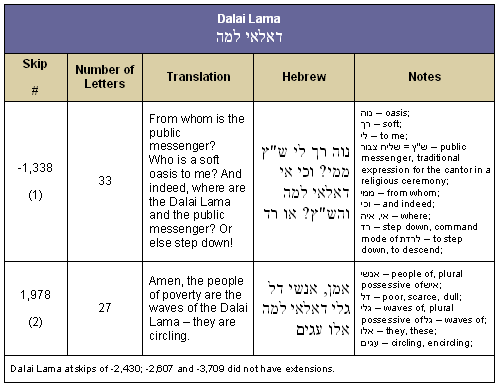
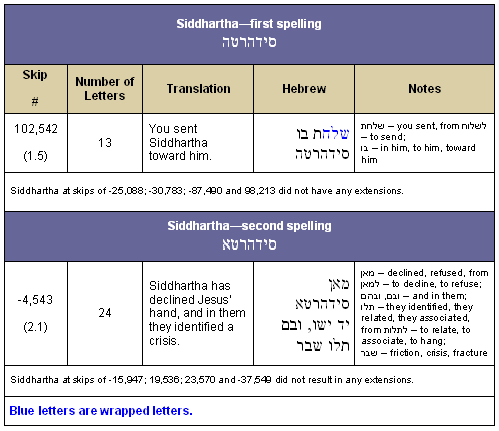
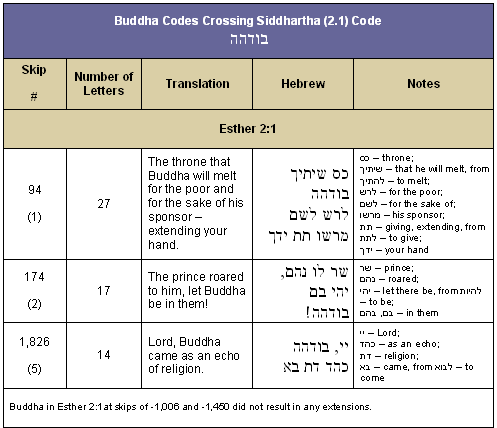
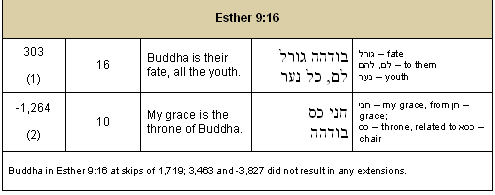
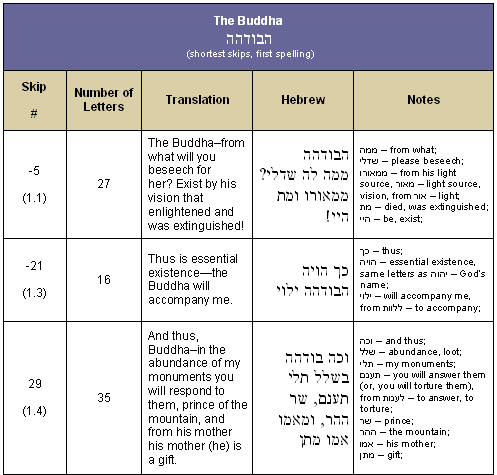
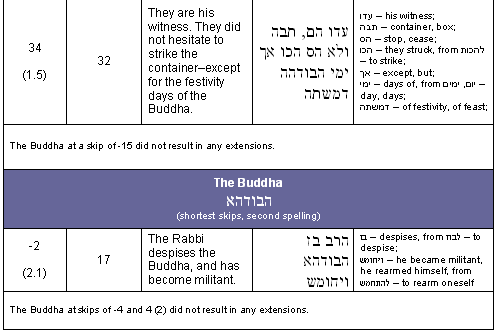
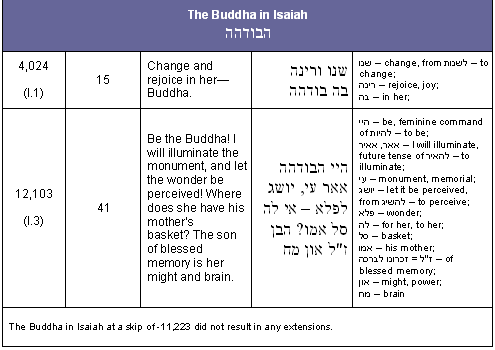
Scripture quotations marked "NIV" are taken from the HOLY BIBLE, NEW INTERNATIONAL VERSION®. NIV® Copyright ©1973, 1978, 1984 by International Bible Society. Used by permission of Zondervan. All rights reserved.
Buddha Codes
|
Enjoy finding your own Bible codes.
Bible code search software is available in our online store.
Subscribe Free! Sign Up Today!
Become a member of the non-profit Isaac Newton Bible Code Research Society.
Not only will you be part of the world's leading organization researching and publicizing Bible and Torah codes, but you will receive Bible Code Digest absolutely free, including . . .
- Latest Bible Code News
- Easy-to-Understand Bible Code Feature Articles
- Exciting Inside Information from Leading Code Researchers
- Details of Great New Discoveries
- Summaries of the Latest Battles Between Code Proponents and Skeptics
Stay current on Bible code news. Be first to hear about all of the latest Bible code discoveries.
Sign up to receive Bible Code Digest today.
|
|


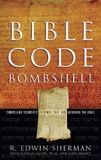 
Bombshell examines two massive, recently discovered clusters of codes in the Hebrew Old Testament. To read more about Bombshell, click here, or click below to order from Amazon today!
 
|







